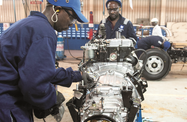A number of automotive manufacturers have recently committed to increase production activity in Kenya, benefiting in part from the roll-out of new fiscal incentives.

Earlier this month France’s Peugeot announced plans to restart production in Kenya, having halted manufacturing operations there 15 years ago. The firm will produce 1000 of its “508” and “3008” models in its first year, with distribution to be managed by domestic company URYSIA.
The news came on the back of Germany’s Volkswagen inaugurating a new production facility in Thika outside Nairobi at the end of 2016. The company is initially focusing on assembly of its Polo Vivo family saloon, constructing the units in-house from complete knock-down (CKD) kits imported from its plants overseas. In the first phase, the plant will have an annual production capacity of up to 1000 vehicles – a figure expected to increase to 5000 in the near future.
Assembly incentives
In a move to boost local manufacturing, the government last year announced exemptions on tariffs applied to imports of unassembled vehicles.
Under the new scheme, CKD kits are waived from the 25% import duty and 20% excise levy that applies to fully built imports, meaning that locally manufactured cars have a strong price advantage.
A number of companies with assembly operations in Kenya – including Japan’s Toyota and US-based General Motors – are also looking into applying for the incentives, which have so far only been approved for Volkswagen.
General Motors and Toyota’s current operations in Kenya are limited to light commercial vehicles, though both firms may be encouraged to expand into other lines by the scheme.
They were joined in March of last year by US-based manufacturer Daimler Trucks Asia, which began assembling CKD kits for light commercial vehicles in Kenya’s second-largest city, Mombasa.
Purchase guarantee
Demand for domestic production should also see an increase, following a directive handed down by President Uhuru Kenyatta in December, which mandates that government agencies give preference to locally-made vehicles when making new purchases.
Kenyatta also announced that the government had committed to buying at least 300 Volkswagen Polo Vivos per year, a sale that would represent 30% of the company’s first year of output at its Thika plant.
Sales slip in 2016
The new government directive should provide welcome support for local sales figures. While Volkswagen and Peugeot’s recent moves guarantee a boost to local production capacity, last year saw domestic vehicle sales drop by 30% to 13,535, according to a report issued by General Motors East Africa in mid-January.
The decline was the first time in five years leading brands had seen a drop-off in trading. Sales in the final months of 2016 were among the lowest of the year, at 1078 and 925 in November and December, respectively.
Some of the decrease has been blamed on the Excise Duty Act of 2015, which set a tax of Sh200,000 ($1930) for imported vehicles more than three years old and Sh150,000 ($1450) for newer models. The new taxes replaced a 20% tariff based on a vehicle’s value, meaning that popular budget models saw large price increases. However, following lobbying by the Kenyan Association of Manufacturers as well as a number of other sector stakeholders, the old regime was reinstated in mid-2016.
While the change in excise tariffs in 2015 helped lower the price of expensive high-end vehicles, sales in the segment throughout the year were also low according to the General Motors report, suggesting a broader range of factors were at play.
Potential obstacles to growth
A 2016 report by Deloitte suggested that there is plenty of room for growth in local vehicle sales. Currently, the country of 44m has a total vehicle fleet of just over 1.3m, putting the ownership rate at around 28-29 vehicles per 1000 people. Just as important, the vast majority of those vehicles – roughly four-fifths – are second-hand and frequently driven on ageing or unpaved roads. This means breakdowns are frequent and replacements are in high demand.
Such growth potential may be constrained by the government’s Standard Gauge Railway project, a multi-billion dollar infrastructure investment that will dramatically expand the capacity and efficiency of rail links along key transport corridors.
Demand for large passenger vehicles might be impacted if commuters shift to rail services, according to Bobby Virdee, managing director of Master Fabricators, a Nairobi-based bus, truck and coach body builder. However, if the extended network has ample multimodal links, there could be knock-on benefits for vehicle sales.
“If the train network is implemented well, there will be additional opportunities for bus to train transfers, though this will be contingent on how the transport systems are integrated.” Virdee told OBG.


